Page 4 of 341
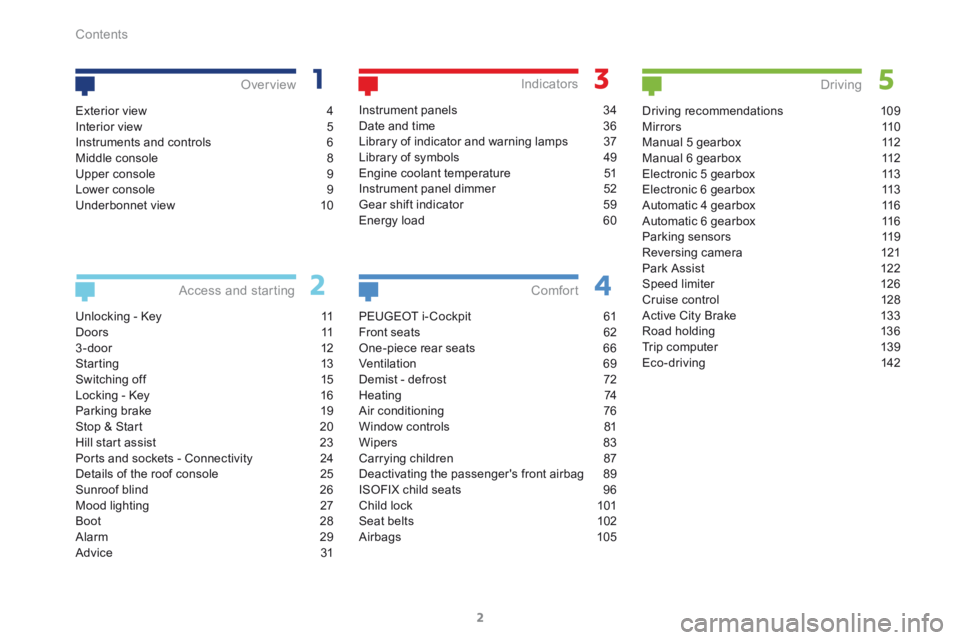
2
208_en_Chap00a_sommaire_ed01-2015
Unlocking - Key 11
D o o r s 11
3 - door 12
Starting 13
Switching off 15
Locking - Key 16
Parking brake 19
Stop & Start 20
Hill start assist 23
Ports and sockets - Connectivity 24
Details of the roof console 25
Sunroof blind 26
Mood lighting 27
Boot 28
Alarm 29
Advice 31
Access and starting Over view
Instrument panels
34
Date and time 36
Library of indicator and warning lamps 37
Library of symbols 49
Engine coolant temperature 51
Instrument panel dimmer 52
Gear shift indicator 59
Energy load 60
Indicators
PEUGEOT i- Cockpit 61
Front seats 62
One-piece rear seats 66
Ventilation 69
Demist - defrost 72
Heating 74
Air conditioning 76
Window controls 81
Wipers 83
Carrying children 87
Deactivating the passenger's front airbag 89
ISOFIX child seats 96
Child lock 101
Seat belts 102
Airbags 105
Comfort
Driving recommendations 109
M i r r o r s 11 0
Manual 5 gearbox 112
Manual 6 gearbox 112
Electronic 5 gearbox 113
Electronic 6 gearbox 113
Automatic 4 gearbox 116
Automatic 6 gearbox 116
Parking sensors 119
Reversing camera 121
Park Assist 122
Speed limiter 126
Cruise control 128
Active City Brake 133
Road holding 136
Trip computer 139
Eco-driving 142
Driving
Exterior view 4
Interior view 5
Instruments and controls 6
Middle console 8
Upper console 9
Lower console 9
Underbonnet view 10
Contents
Page 6 of 341
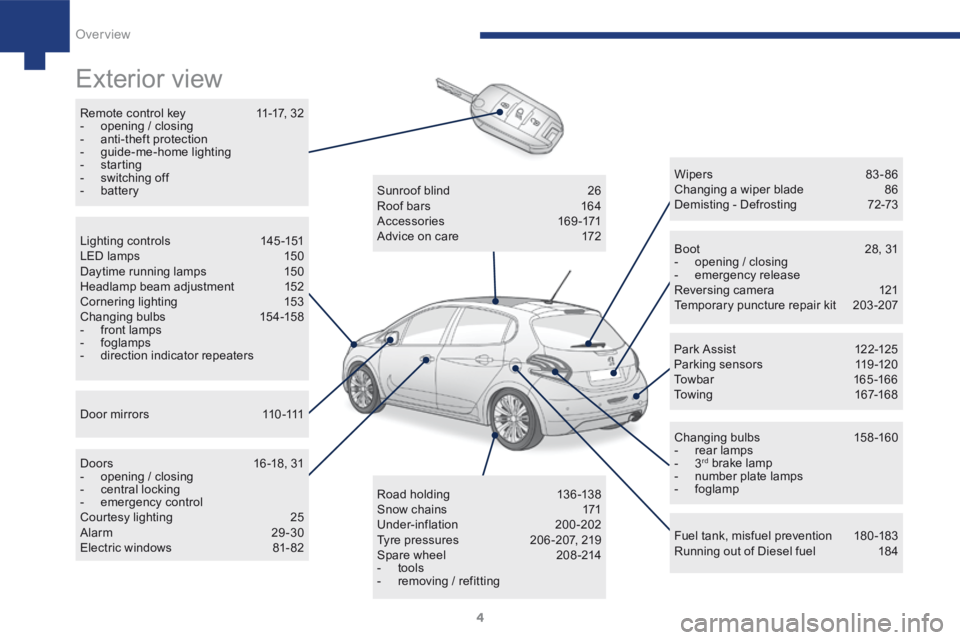
4
208_en_Chap01_vue-ensemble_ed01-2015
Exterior view
Remote control key 11-17, 32
- opening / closing
- anti-theft protection
- guide-me-home lighting
- starting
- switching off
- battery
Boot 28, 31
- opening / closing
- emergency release
Reversing camera 121
Temporary puncture repair kit 203-207
Wipers 83 - 86
Changing a wiper blade
86
Demisting - Defrosting 72-73
Changing bulbs 158-160
- rear lamps
- 3
rd brake lamp
- number plate lamps
- foglamp
Fuel tank, misfuel prevention 180-183
Running out of Diesel fuel 184
Sunroof blind
26
Roof bars 164
Accessories 169-171
Advice on care 172
Road holding 13 6 -13 8
Snow chains 171
Under-inflation 200-202
Tyre pressures 206 -207, 219
Spare wheel 208-214
- tools
- removing / refitting
Lighting controls
145-151
LED lamps 150
Daytime running lamps 150
Headlamp beam adjustment 152
Cornering lighting 153
Changing bulbs 154-158
- front lamps
- foglamps
- direction indicator repeaters
D o o r m i r r o r s 11 0 -111
Doors 16 -18, 31
- opening / closing
- central locking
- emergency control
Courtesy lighting 25
Alarm 29-30
Electric windows 81- 82 Par k A ssist
12 2-125
Parking sensors 119-120
Towbar 165 -166
Towing 167-168
Over view
Page 7 of 341
5
208_en_Chap01_vue-ensemble_ed01-2015
Interior view
Boot f ittings 163 -16 4
- rear parcel shelf
- hooks
- boot lamp
- lashing rings Front seats
62-64
Heated seats 65
Front arm rest 65
Child seats 87-100
Child seats used with a 3 -point seat belt 93 -95
ISOFIX child seats 96 -99
Manual child lock 101
Electric child lock 101 Airbags
105 -108
Interior mirror 111
Parking brake 19
Moving off on a slope 23
Interior fittings
24, 161-162
- 12 V accessory socket
- USB port / Auxiliary socket
- illuminated glove box
- mats
Deactivating the passenger's front airbag 89, 106
Seat belts 102-104
Warning triangle 199
Rear seats
66-68
1
Over view
Page 16 of 341
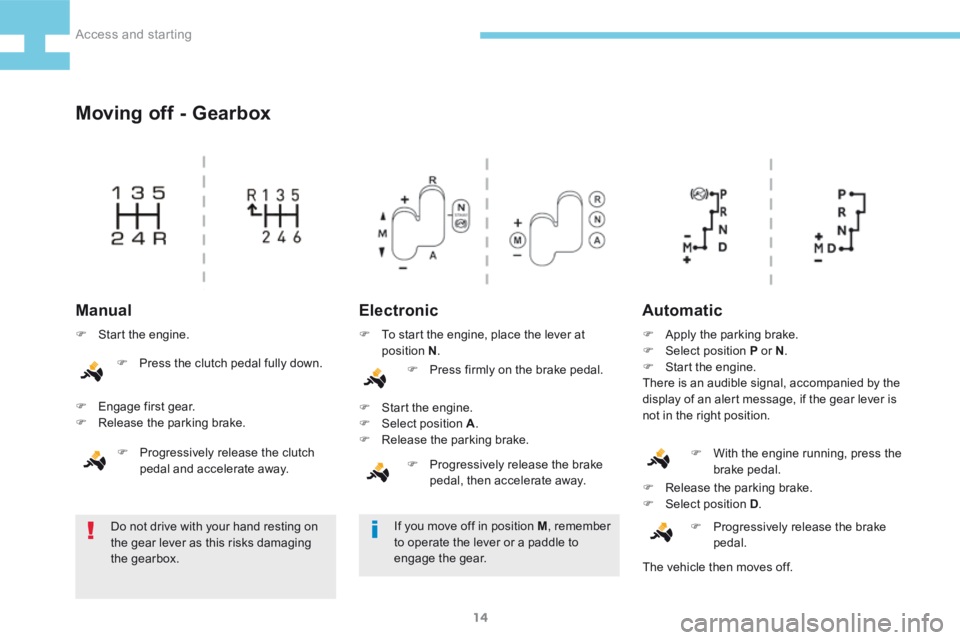
14
208_en_Chap02_ Acces-Demarrage_ed01-2015
Moving off - Gearbox
ElectronicAutomatic
Do not drive with your hand resting on
the gear lever as this risks damaging
the gearbox. F
Release the parking brake.
F Select position D .
F Progressively release the brake
pedal.
Manual
F Start the engine.
F Engage first gear.
F Release the parking brake.
F Progressively release the clutch
pedal and accelerate away. F
To start the engine, place the lever at
position N .
F Press firmly on the brake pedal.
F Start the engine.
F Select position A .
F Release the parking brake.
F Progressively release the brake
pedal, then accelerate away. F
Apply the parking brake.
F Select position P or N .
F Start the engine.
There is an audible signal, accompanied by the
display of an alert message, if the gear lever is
not in the right position.
If you move off in position M , remember
to operate the lever or a paddle to
engage the gear. F
With the engine running, press the
brake pedal.
The vehicle then moves off.
F
Press the clutch pedal fully down.
Access and starting
Page 17 of 341
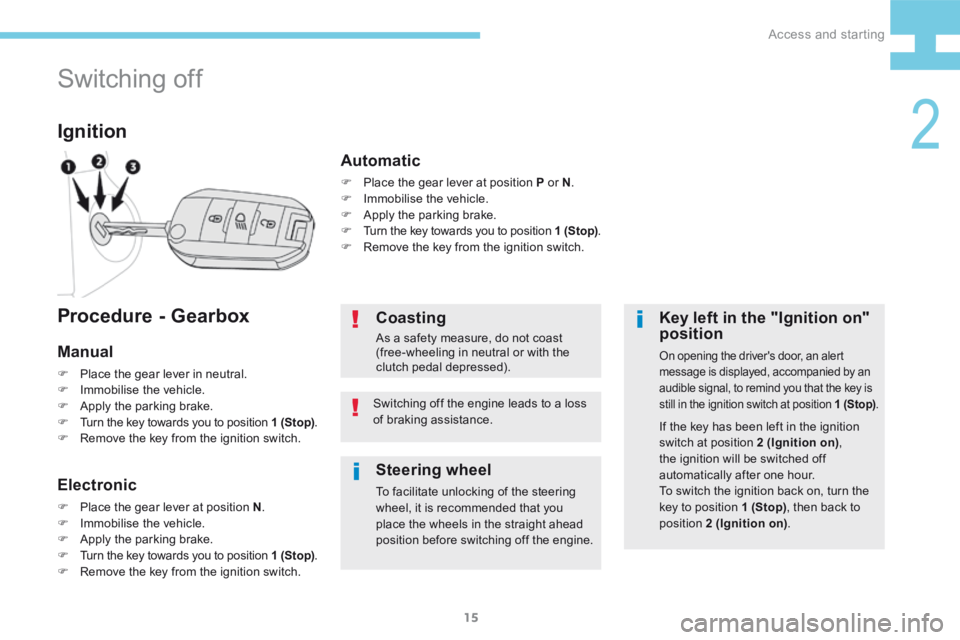
15
208_en_Chap02_ Acces-Demarrage_ed01-2015
Switching off
Ignition
Key left in the "Ignition on"
position
On opening the driver's door, an alert
message is displayed, accompanied by an
audible signal, to remind you that the key is
still in the ignition switch at position 1 (Stop).
If the key has been left in the ignition
switch at position 2 (Ignition on),
the ignition will be switched off
automatically after one hour.
To switch the ignition back on, turn the
key to position 1 (Stop) , then back to
position 2 (Ignition on) .
Coasting
As a safety measure, do not coast
(free-wheeling in neutral or with the
clutch pedal depressed).
Switching off the engine leads to a loss
of braking assistance.
Procedure - Gearbox
Manual
F Place the gear lever in neutral.
F Immobilise the vehicle.
F Apply the parking brake.
F Turn the key towards you to position 1 (Stop) .
F Remove the key from the ignition switch.
Electronic
F Place the gear lever at position N .
F Immobilise the vehicle.
F Apply the parking brake.
F Turn the key towards you to position 1 (Stop) .
F Remove the key from the ignition switch.
Automatic
F Place the gear lever at position P or N .
F Immobilise the vehicle.
F Apply the parking brake.
F Turn the key towards you to position 1 (Stop) .
F Remove the key from the ignition switch.
Steering wheel
To facilitate unlocking of the steering
wheel, it is recommended that you
place the wheels in the straight ahead
position before switching off the engine.
2
Access and starting
Page 21 of 341
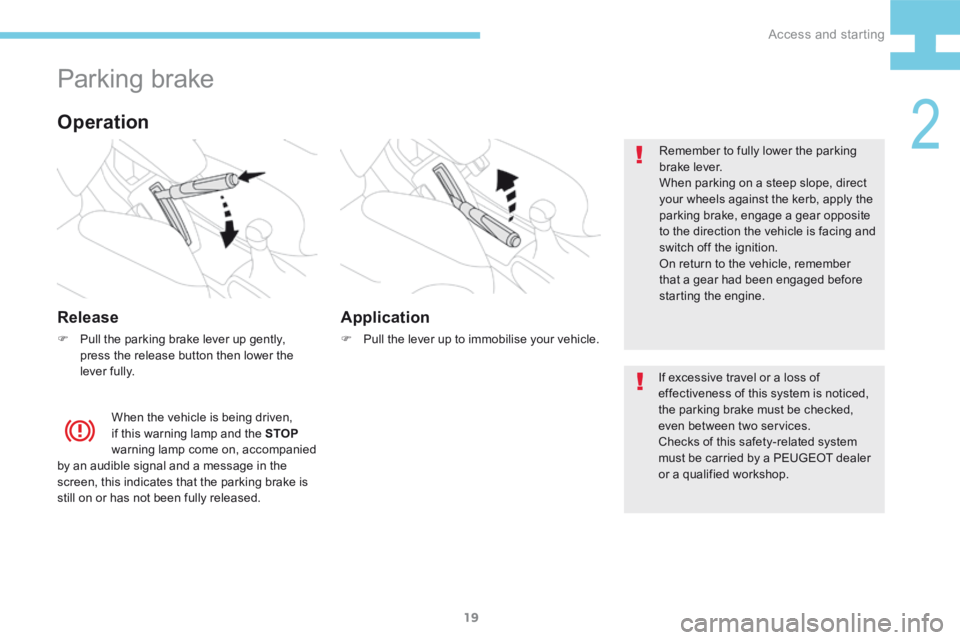
19
208_en_Chap02_ Acces-Demarrage_ed01-2015
Parking brake
Release
F Pull the parking brake lever up gently,
press the release button then lower the
lever fully. Remember to fully lower the parking
brake lever.
When parking on a steep slope, direct
your wheels against the kerb, apply the
parking brake, engage a gear opposite
to the direction the vehicle is facing and
switch off the ignition.
On return to the vehicle, remember
that a gear had been engaged before
starting the engine.
When the vehicle is being driven,
if this warning lamp and the STOP
warning lamp come on, accompanied
by an audible signal and a message in the
screen, this indicates that the parking brake is
still on or has not been fully released.
Operation
If excessive travel or a loss of
effectiveness of this system is noticed,
the parking brake must be checked,
even between two services.
Checks of this safety-related system
must be carried by a PEUGEOT dealer
or a qualified workshop.
Application
F Pull the lever up to immobilise your vehicle.
2
Access and starting
Page 23 of 341
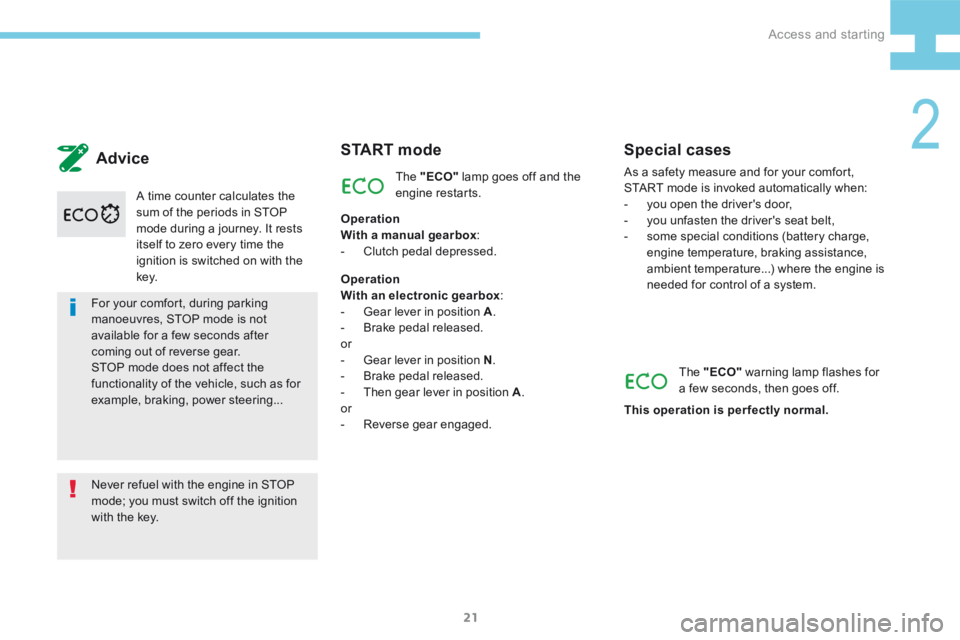
21
208_en_Chap02_ Acces-Demarrage_ed01-2015
For your comfort, during parking
manoeuvres, STOP mode is not
available for a few seconds after
coming out of reverse gear.
STOP mode does not affect the
functionality of the vehicle, such as for
example, braking, power steering...
Never refuel with the engine in STOP
mode; you must switch off the ignition
with the key.A time counter calculates the
sum of the periods in STOP
mode during a journey. It rests
itself to zero every time the
ignition is switched on with the
key.
Advice
Special casesAs a safety measure and for your comfort,
START mode is invoked automatically when:
-
you open the driver's door,
- you unfasten the driver's seat belt,
- some special conditions (battery charge,
engine temperature, braking assistance,
ambient temperature...) where the engine is
needed for control of a system.
The "ECO" warning lamp flashes for
a few seconds, then goes off.
This operation is perfectly normal.
S TA R T m o d e
Operation
With a manual gearbox :
- Clutch pedal depressed.
Operation
With an electronic gearbox :
- Gear lever in position A .
- Brake pedal released.
or
- Gear lever in position N .
- Brake pedal released.
- Then gear lever in position A .
or
- Reverse gear engaged. The "ECO"
lamp goes off and the
engine restarts.
2
Access and starting
Page 25 of 341
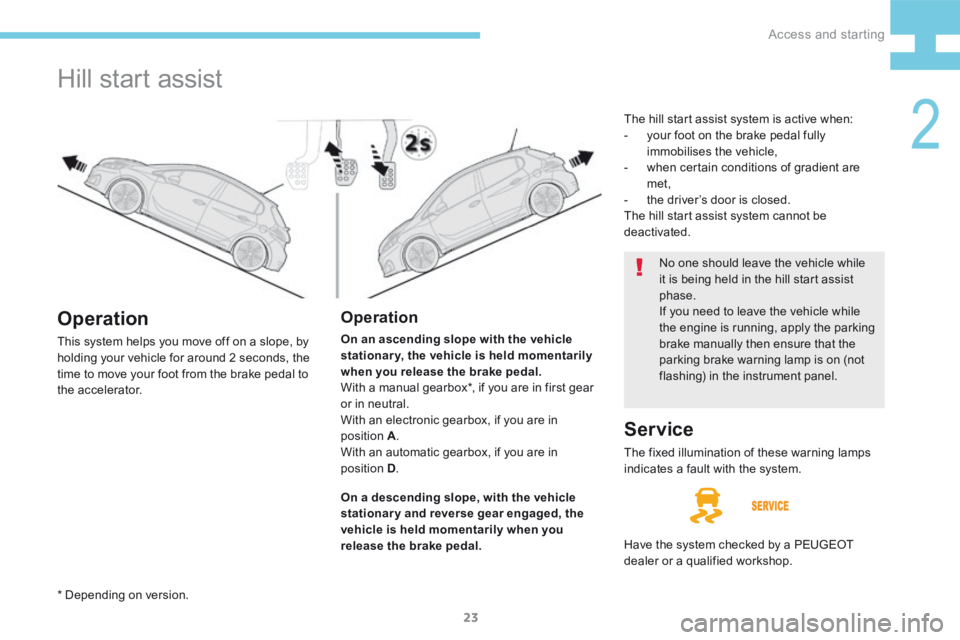
23
208_en_Chap02_ Acces-Demarrage_ed01-2015
Hill start assist
Operation
On an ascending slope with the vehicle
stationary, the vehicle is held momentarily
when you release the brake pedal.
With a manual gearbox*, if you are in first gear
or in neutral.
With an electronic gearbox, if you are in
position A .
With an automatic gearbox, if you are in
position D .
Operation
This system helps you move off on a slope, by
holding your vehicle for around 2 seconds, the
time to move your foot from the brake pedal to
the accelerator.
On a descending slope, with the vehicle
stationary and reverse gear engaged, the
vehicle is held momentarily when you
release the brake pedal. No one should leave the vehicle while
it is being held in the hill start assist
phase.
If you need to leave the vehicle while
the engine is running, apply the parking
brake manually then ensure that the
parking brake warning lamp is on (not
flashing) in the instrument panel.
Service
The fixed illumination of these warning lamps
indicates a fault with the system.
Have the system checked by a PEUGEOT
dealer or a qualified workshop. The hill start assist system is active when:
-
your foot on the brake pedal fully
immobilises the vehicle,
- when certain conditions of gradient are
met,
- the driver’s door is closed.
The hill start assist system cannot be
deactivated.
* Depending on version.
2
Access and starting